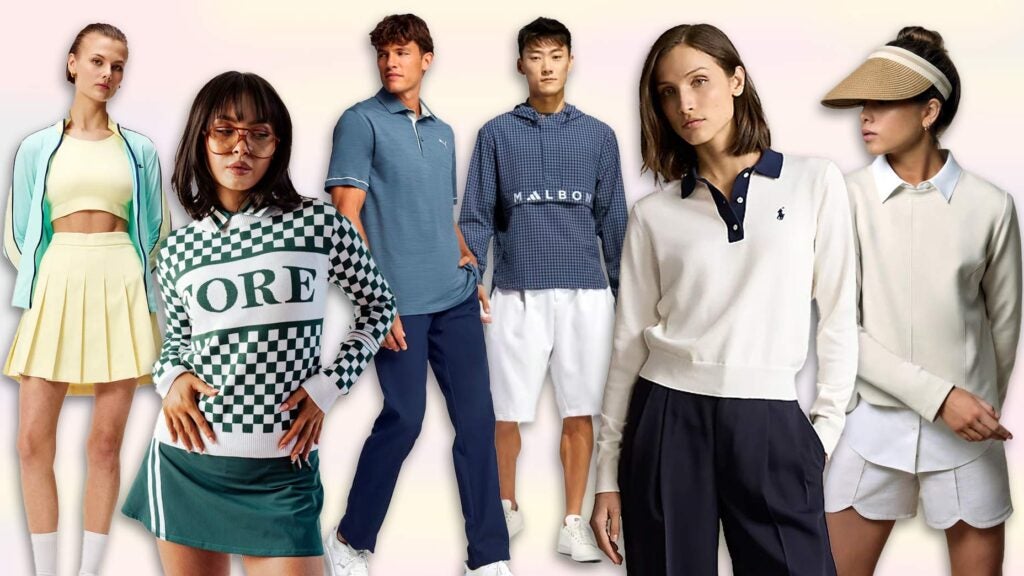Branded Clothing for Travel: Wrinkle-Resistant Fabrics That Perform
Branded Clothing for Travel: Wrinkle-Resistant Fabrics That Perform
Blog Article
The Relevance of Sustainable Garments: How It Influences the Environment and Your Storage room
Lasting clothes is significantly recognized for its essential function in decreasing the environmental effect of the rapid garment industry. By concentrating on eco-friendly materials and honest manufacturing approaches, it resolves pressing environmental problems. This change not only benefits the planet yet also influences consumer options, causing an extra thoughtful strategy to wardrobe management. Recognizing these characteristics elevates important concerns concerning style's future and individual duty in forming it.
The Ecological Impact of Fast Fashion

Benefits of Sustainable Products
Sustainable materials provide significant advantages, particularly via environment-friendly textile options that lessen ecological damage. These materials additionally demonstrate toughness and long life, lowering the demand for constant substitutes. Therefore, they add to a more sustainable style sector and promote responsible customer habits.
Eco-Friendly Material Choices
While the apparel industry has actually long been related to fast fads and ecological harm, the surge of green fabric choices offers a transformative opportunity. Lasting materials such as natural cotton, hemp, and Tencel have gained appeal because of their lower eco-friendly impact. These fabrics are usually generated without hazardous chemicals and require less water, reducing their carbon impact - Branded Clothing. Additionally, numerous eco-friendly materials are naturally degradable, adding to a circular economy by lessening waste. Choosing lasting products not only sustains eco accountable techniques but likewise advertises healthier environments. As customers become a lot more knowledgeable about their purchasing power, the demand for green fabrics encourages brands to introduce and take on more lasting manufacturing methods, ultimately benefiting the world and future generations
Durability and Durability Benefits
Lots of consumers are increasingly identifying the resilience and longevity benefits of sustainable products in their apparel options. Unlike traditional textiles, lasting materials such as organic cotton, hemp, and recycled polyester are engineered to hold up against damage, resulting in garments that last much longer. This reduced regularity of substitute not just saves consumers cash over time however likewise reduces waste created by quick fashion. In addition, lasting clothing typically utilizes green manufacturing techniques that improve fabric strength, contributing to a reduction in the total carbon impact. By buying durable clothing, customers can cultivate an extra sustainable closet while enjoying top notch items that maintain their aesthetic and capability over time. Resilience and durability stand as key advantages of selecting sustainable materials.
Decreasing Waste Through Lasting Practices
Reducing waste in the fashion business can be attained through cutting-edge practices such as upcycling and repurposing products. Additionally, taking on minimalist wardrobe techniques urges consumers to focus on quality over quantity, inevitably reducing apparel intake. Together, these techniques contribute substantially to a much more lasting clothing model.
Upcycling and Repurposing Products
Upcycling and repurposing materials have arised as innovative methods in the style industry, changing discarded fabrics right into useful brand-new products. This technique not only decreases waste but additionally urges creativity and originality in clothes style. By taking old garments and materials, designers can produce one-of-a-kind pieces that show individual design while reducing the need for brand-new resources. Furthermore, upcycling often needs much less power and water contrasted to typical production procedures, significantly decreasing the ecological impact of fashion. As consumers end up being a lot more conscious of sustainability, the appeal of upcycled garments remains to climb, advertising a round economy. Eventually, these practices add to a much more sustainable future, where style focuses on ecological health over rapid manufacturing and intake.

Minimalist Closet Methods
As individuals progressively seek to decrease their environmental influence, adopting minimal closet techniques has gotten traction as an efficient approach to sustainable style. These approaches highlight top quality over quantity, motivating customers to curate a smaller collection of flexible, sturdy clothes. By concentrating on timeless pieces that can be combined and matched, people can reduce the frequency of acquisitions and inevitably decrease waste.Additionally, minimalism advertises conscious consumption, advising buyers to reflect on the honest and ecological ramifications of their options. This strategy not only promotes a much more sustainable way of life yet additionally simplifies day-to-day decision-making relating to clothes. As individuals welcome minimal principles, they add to a style society that values sustainability and liable consumerism, inevitably resulting in a more eco-conscious society.
The Role of Ethical Labor in Sustainable Fashion
While several customers are increasingly aware of the environmental consequences of their clothing choices, the significance of moral labor methods in sustainable fashion can not be forgotten. Moral labor includes fair salaries, risk-free working conditions, and regard for employees' legal rights, forming the foundation of liable fashion production. Brand names that prioritize ethical labor not just boost communities yet additionally set a criterion for liability in the industry.Moreover, the integration of ethical techniques cultivates transparency, making it possible for consumers to make enlightened choices about their acquisitions. This practice contrasts greatly with rapid style's unscrupulous labor versions, which frequently prioritize profit over people. By sustaining companies devoted to honest labor, customers add to a system that values human dignity alongside ecological sustainability. Ethical labor is not just an add-on; it is essential to the wider objective of lasting style, making certain that the pursuit for eco-friendliness does not come at the expense of human civil liberties.
The Impact of Sustainable Clothes on Carbon Emissions
Sustainable clothes has the prospective to considerably decrease carbon discharges connected with the garment industry. Traditional garment production adds especially to greenhouse gas exhausts, largely due to energy-intensive manufacturing procedures and making use of non-renewable sources. In comparison, sustainable fashion focuses YOURURL.com on green products, such as organic cotton or recycled fibers, which commonly need less energy to produce.Moreover, lasting brand names have a tendency to embrace more efficient production methods, lessening waste and reducing overall exhausts. By focusing on toughness and timeless design, lasting clothes encourages customers to get less regularly, additional minimizing the carbon footprint related to overconsumption.Additionally, lots of lasting brands are dedicated to openness in their supply chains, allowing consumers to make educated choices that line up with their worths. Eventually, shifting towards lasting garments can result in a considerable decrease in carbon exhausts, contributing to a much healthier planet and a much more lasting future for the apparel industry.
Supporting Local Economic Climates With Lasting Choices
The shift towards sustainable clothing not just addresses environmental issues but also significantly advantages regional economic situations. By picking lasting fashion, consumers often support little organizations and regional craftsmens, enhancing community durability. These business typically operate on a smaller scale, focusing on craftsmanship and ethical practices over mass production.Investing in locally made sustainable clothing fosters job creation and stimulates economic growth within communities. As consumers become more knowledgeable about the environmental impact of their acquisitions, they increasingly look for out items that show their values. This demand encourages local manufacturers to adopt lasting methods, contributing to a circular economy.Moreover, supporting local companies minimizes transport discharges, lining up with eco-conscious consumer habits. The interconnectedness of sustainable clothing and neighborhood economic climates underscores the necessary role that specific choices play in promoting both ecological and economic health and wellness. By fostering these neighborhood links, communities can thrive while additionally functioning towards an extra check out here lasting future.
Transforming Your Wardrobe: Tips for a Sustainable Closet
As individuals seek to minimize their ecological influence, changing a wardrobe right into a sustainable wardrobe becomes an essential action. One effective approach is to examine existing clothing, maintaining only things that are put on regularly and that line up with sustainability objectives. Prioritizing top quality over quantity is essential; purchasing long lasting pieces from eco-friendly brands can greatly decrease waste.Additionally, including used items can revive a wardrobe while minimizing ecological damages. Organizing garments swaps with pals or donating extra items can additionally promote sustainability.When purchasing, individuals must look for products that are organic, recycled, or naturally degradable, and stay clear of fast fashion stores - Branded Clothing. Finally, practicing mindful usage by thoughtfully taking into consideration each purchase can contribute to a much more sustainable lifestyle. By implementing these suggestions, one can produce a closet that mirrors individual style while sustaining ecological stewardship
Frequently Asked Concerns
Exactly How Can I Recognize Sustainable Clothes Brands?
To determine lasting clothes brand names, one need to investigate materials utilized, look for accreditations like Fair Trade, and take a look at the brand name's openness regarding their production procedures, labor techniques, and ecological impact, ensuring moral and environmentally friendly techniques are prioritized.
What Are the Prices Associated With Sustainable Style?
The expenses connected with sustainable style can vary significantly. Greater manufacturing expenses, ethical sourcing, and green materials usually bring about increased retail rates, which may hinder some consumers while interesting environmentally conscious buyers.
Can Lasting Garments Be Fashionable and elegant?
Lasting garments can undoubtedly be fashionable and fashionable. Developers increasingly prioritize innovative products and moral production methods, confirming that style and sustainability can exist side-by-side. Consumers currently have varied alternatives her latest blog that mix looks with environmental awareness.
Exactly How Does Laundering Clothes Affect Their Sustainability?
Cleaning garments substantially impacts sustainability by consuming water and energy, adding to pollution, and creating microplastic launch. Regular cleaning can deteriorate materials, shortening their life expectancy and boosting the requirement for substitutes, ultimately worsening ecological concerns.
What Is the Lifespan of Sustainable Apparel Contrasted to Quick Fashion?
The life-span of lasting apparel generally exceeds that of quick fashion items, frequently lasting a number of years due to quality materials and craftsmanship. On the other hand, fast style garments may deteriorate quickly, demanding even more regular substitutes. Sustainable garments is progressively identified for its vital role in minimizing the ecological influence of the quick style market. While lots of customers are significantly mindful of the ecological effects of their clothing options, the importance of moral labor techniques in sustainable fashion can not be forgotten. Branded Clothing. Sustainable garments has the possible to considerably reduce carbon discharges associated with the fashion market. In contrast, sustainable fashion focuses on environmentally friendly materials, such as organic cotton or recycled fibers, which often need less power to produce.Moreover, sustainable brand names have a tendency to take on more effective manufacturing techniques, minimizing waste and lowering overall emissions. By prioritizing sturdiness and classic style, sustainable clothing motivates customers to buy less often, additional lowering the carbon impact associated with overconsumption.Additionally, several sustainable brand names are dedicated to openness in their supply chains, enabling customers to make informed choices that line up with their values
Report this page